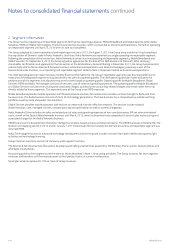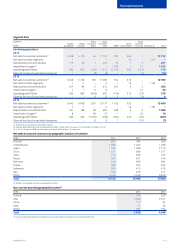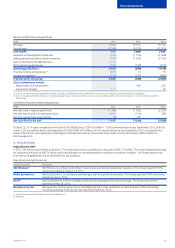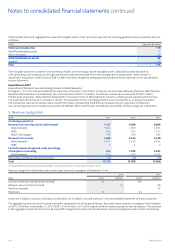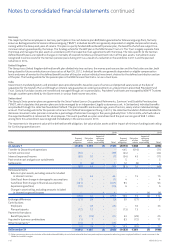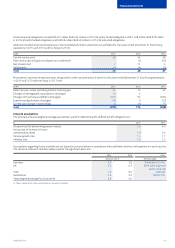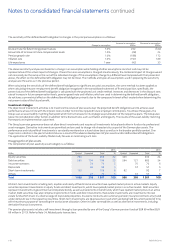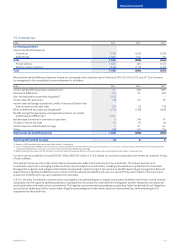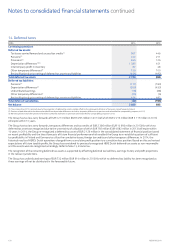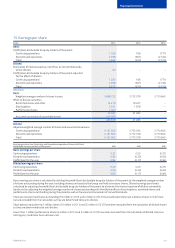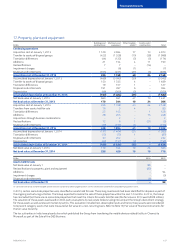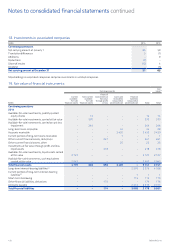Nokia 2014 Annual Report Download - page 150
Download and view the complete annual report
Please find page 150 of the 2014 Nokia annual report below. You can navigate through the pages in the report by either clicking on the pages listed below, or by using the keyword search tool below to find specific information within the annual report.
148 NOKIA IN 2014
The sensitivity of the dened benet obligation to changes in the principal assumptions is as follows:
Change in assumption
Increase in assumption
EURm
Decrease in assumption
EURm
Discount rate for determining present values 1.0% 252 (332)
Annual rate of increase in future compensation levels 1.0% (28) 24
Pension growth rate 1.0% (188) 172
Ination rate 1.0% (197) 189
Life expectancy 1 year (42) 35
The above sensitivity analyses are based on a change in an assumption while holding all other assumptions constant and may not be
representative of the actual impact of changes. If more than one assumption is changed simultaneously, the combined impact of changes would
not necessarily be the same as the sum of the individual changes. If the assumptions change to a dierent level compared with that presented
above, the eect on the dened benet obligation may not be linear. The methods and types of assumptions used in preparing the sensitivity
analyses are the same as in the previous period.
When calculating the sensitivity of the dened benet obligation to signicant actuarial assumptions, the same method has been applied as
when calculating the post-employment benet obligation recognized in the consolidated statement of nancial position; specically, the
present value of the dened benet obligation is calculated with the projected unit credit method. Increases and decreases in the discount rate,
rate of increase in future compensation levels, pension growth rate and ination, which are used in determining the dened benet obligation,
do not have a symmetrical eect on the dened benet obligation primarily due to the compound interest eect created when determining the
net present value of the future benet.
Investment strategies
The objective of investment activities is to maximize the excess of plan assets over the projected benet obligations and to achieve asset
performance at least in line with the interest costs in order to minimize required future employer contributions. To achieve these goals, the
Group uses an asset liability matching framework which forms the basis for its strategic asset allocation of the respective plans. The Group also
takes into consideration other factors in addition to the discount rate, such as ination and longevity. The results of the asset-liability matching
framework are implemented on a plan level.
The Group’s pension governance does not allow direct investments and requires all investments to be placed either in funds or by professional
asset managers. Derivative instruments are permitted and are used to change risk characteristics as part of the German plan assets. The
performance and risk prole of investments is constantly monitored on a stand-alone basis as well as in the broader portfolio context. One
major risk is a decline in the plan’s funded status as a result of the adverse development of plan assets and/or dened benet obligations.
The application of the Asset-Liability-Model study focuses on minimizing such risks.
Disaggregation of plan assets
The composition of plan assets by asset category is as follows:
EURm
2014 2013
Quoted Unquoted Total %Quoted Unquoted Total %
Equity securities 296 296 22 300 300 24
Debt securities 665 104 769 55 564 121 685 54
Insurance contracts 74 74 570 70 6
Real estate 68 68 557 57 5
Short-term investments 108 108 892 92 7
Others 72 72 557 57 5
Total 1 069 318 1 387 100 956 305 1 261 100
All short-term investments including cash, equities and nearly all xed income securities have quoted market prices in active markets. Equity
securities represent investments in equity funds and direct investments, which have quoted market prices in an active market. Debt securities
represent investments in government and corporate bonds, as well as investments in bond funds, which have quoted market prices in an active
market. Debt securities may also comprise investments in funds and direct investments. Real estate investments are investments into real
estate funds which invest in a diverse range of real estate properties. Insurance contracts are customary pension insurance contracts structured
under domestic law in the respective countries. Short-term investments are liquid assets or cash which are being held for a short period of time,
with the primary purpose of controlling the tactical asset allocation. Other includes commodities as well as alternative investments, including
derivative nancial instruments.
The pension plan assets include a self-investment through a loan provided by one of the Group’s German pension funds of EUR 69 million (EUR
69 million in 2013). Refer to Note 34, Related party transactions.
Notes to consolidated nancial statements continued




